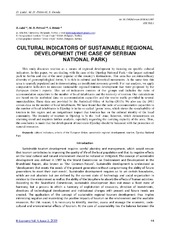Приказ основних података о документу
Cultural indicators of sustainable regional development (the case of Serbian national park)
| dc.contributor | Turgel, Irina Dmitrievna | |
| dc.contributor | Kuklin, Aleksandr Anatolyevich | |
| dc.contributor | Agarkov, Gavriil Aleksandrovich | |
| dc.creator | Lukić, Dobrila | |
| dc.creator | Petrović, Marko D. | |
| dc.creator | Denda, Stefan | |
| dc.date.accessioned | 2018-07-03T19:29:34Z | |
| dc.date.available | 2018-07-03T19:29:34Z | |
| dc.date.issued | 2018 | |
| dc.identifier.issn | 2412-073 | |
| dc.identifier.uri | http://r-economy.ru/cultural-indicators-of-sustainable-regional-development-the-case-of-serbian-national-park/ | |
| dc.identifier.uri | https://dais.sanu.ac.rs/123456789/3443 | |
| dc.description.abstract | This study discusses tourism as a means of regional development by focusing on specific cultural indicators. In this paper, we are dealing with the case of the Djerdap National Park – the largest national park in Serbia and one of the most popular of the country's destinations. This area has an extraordinary diversity of geomorphological forms, it is rich in cultural and historical monuments. At the same time, this area is sparsely populated and is demonstrating an insufficient economic growth. For our analysis, we apply comparative indicators to measure sustainable regional tourism development that were proposed by the European Union’s experts. This set of indicators consists of five groups and includes the ratio of accommodation capacities to the number of local inhabitants and the intensity of tourism. Our calculations are based on the statistical data on accommodation capacities and the tourist traffic provided in several municipalities. These data are provided by the Statistical Office of Serbia (2015). We also use the 2011 census data on the number of local inhabitants. We have found that the ratio of accommodation capacities to the number of local inhabitants in Djerdap is in the so-called ‘green’ zone, which shows the sustainability of tourism in this region and an insignificant impact that tourism has on the cultural identity of the local community. The intensity of tourism in Djerdap is in the ‘red’ zone, however, which demonstrates an alarming trend and requires further analysis, especially regarding the carrying capacity of the area. Thus, the conclusion is made that the development of tourism in Djerdap should be balanced with the protection of natural resources. | en |
| dc.language.iso | en | sr |
| dc.publisher | Ekaterinburg : Institute of Economics of the Ural Branch of the Russian Academy of Sciences and Ural Federal University | sr |
| dc.relation | info:eu-repo/grantAgreement/MESTD/Integrated and Interdisciplinary Research (IIR or III)/47007/RS// | sr |
| dc.rights | openAccess | sr |
| dc.rights.uri | https://creativecommons.org/licenses/by-nc/4.0/ | |
| dc.source | R-Economy | sr |
| dc.subject | cultural indicators | sr |
| dc.subject | criteria of the European Union | sr |
| dc.subject | sustainable regional development | sr |
| dc.subject | tourism | sr |
| dc.subject | Djerdap National Park | sr |
| dc.title | Cultural indicators of sustainable regional development (the case of Serbian national park) | en |
| dc.type | article | sr |
| dc.rights.license | BY-NC | sr |
| dcterms.abstract | Денда, Стефан; Лукић, Добрила; Петровић, Марко Д.; | |
| dc.rights.holder | Ural Federal University, Ekaterinburg | sr |
| dc.citation.spage | 44 | |
| dc.citation.epage | 48 | |
| dc.citation.volume | 4 | |
| dc.citation.volume | 48 | |
| dc.citation.issue | 2 | |
| dc.identifier.doi | 10.15826/recon.2018.4.2.007 | |
| dc.type.version | publishedVersion | sr |
| dc.identifier.fulltext | https://dais.sanu.ac.rs/bitstream/id/11027/bitstream_11027.pdf | |
| dc.identifier.rcub | https://hdl.handle.net/21.15107/rcub_dais_3443 |

